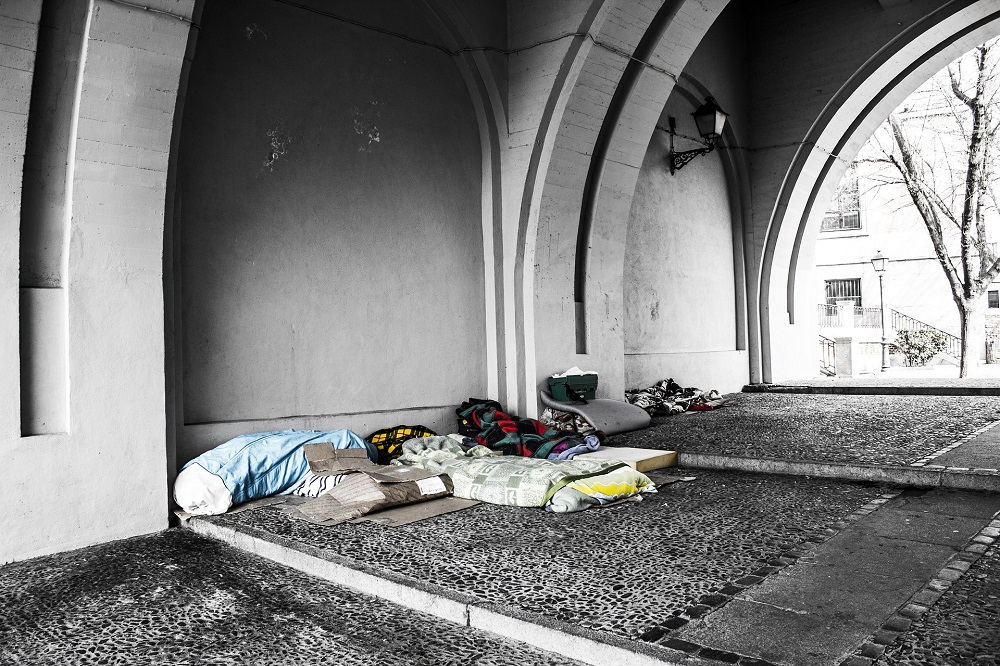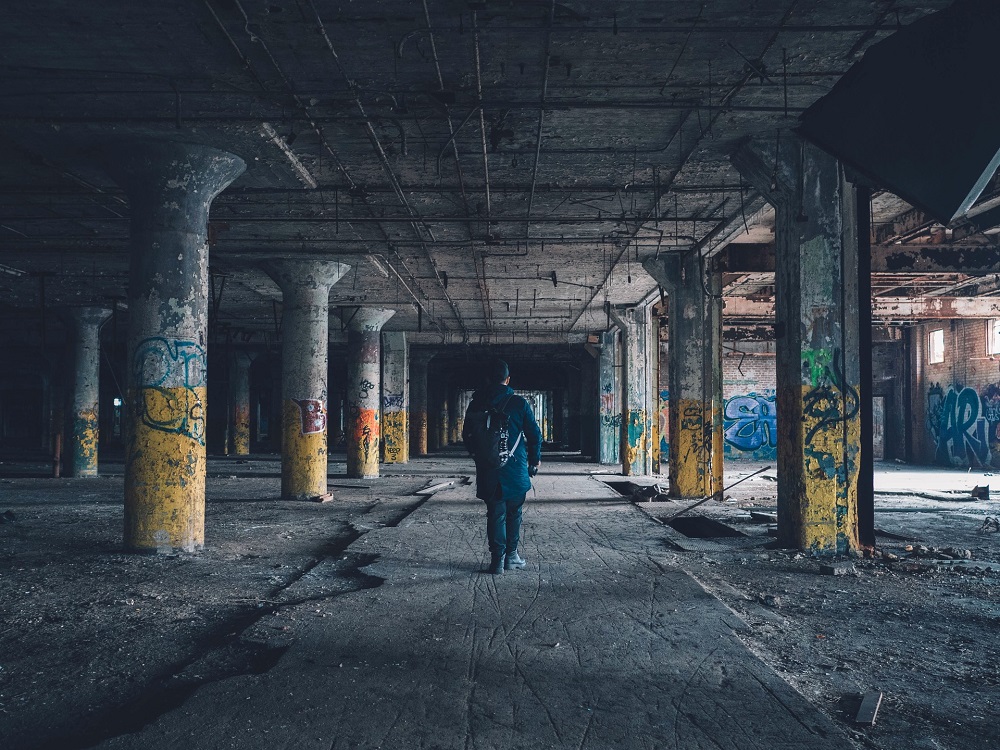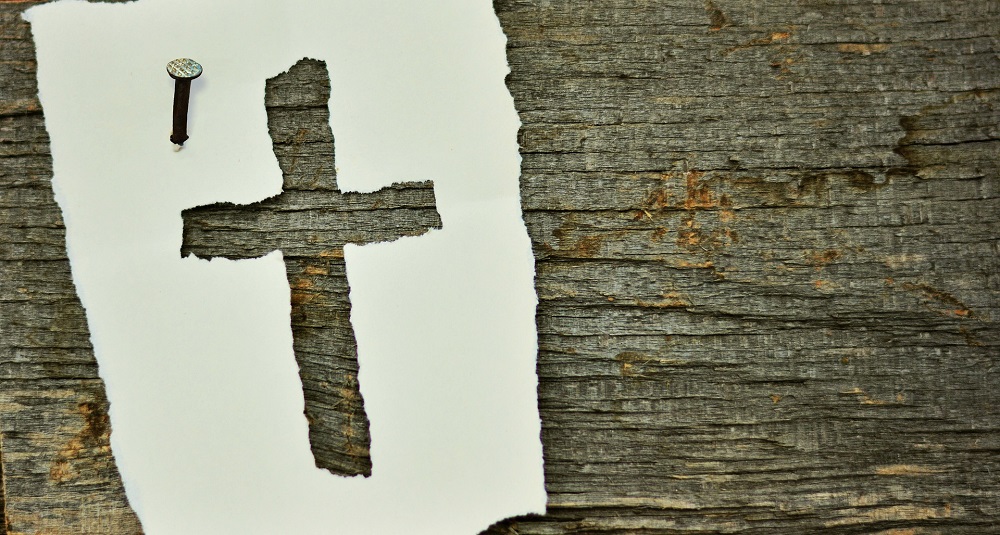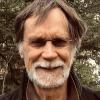
There is no shortage of government studies about homelessness in the United States. Most of those reports attribute the problem to the loss of affordable housing, but that's only part of the story. (Pixabay/José Manuel de Laá)
A stench of garbage and urine drifts on the breeze in the alley off Yesler and Second Avenue. It's a little after 11 a.m., cool, overcast. A soft blanket of condensation from Puget Sound's dark gray waters covers our small group on this Good Friday morning. The sky is gently weeping.
We're paused in front of a stoplight at a congested street corner, not far from the heart of the largest urban area in the Pacific Northwest. What's left of this once prestigious neighborhood is now crowded with pawn shops, taverns and cheap hotels. These littered streets lie less than a mile south of the city center, a few blocks north of Century Link Field, home for the Seattle Seahawks. With a year-around mild climate and tree-shaded park benches, this particular part of Seattle is known across the country as an urban refugee camp, a gathering place for the homeless.
Thirty of us are moving in procession around the streets that border a historic, cobblestoned park called Pioneer Square. We accompany Jesuit Fr. Pat Twohy and a homeless man who carries a cross, nailed together from two pieces of discarded driftwood. Together, we pause to pray in alleyways, under overpasses, outside abandoned storefronts. Most of our procession is made up of persons of Native American descent, the rest from diverse socioeconomic backgrounds, different ethnic groups and various religious traditions. All of us are joining together on this particular Good Friday morning to participate in a centuries-old liturgy rooted in Roman Catholic penitential practice.
The Via Dolorosa, honored in the oldest of Christian liturgical traditions, marks a path through Jerusalem's Old City streets where, it's believed, Jesus once walked, carrying a wooden cross, to the site of his execution. According to church historians, Christian pilgrims began to appropriate the "path of sorrows" to new settings and distant places in the 14th century.
Now, some 2,000 years later in Seattle, in front of homeless shelters and at busy intersections, we, too, are praying our way along 12 Stations of the Cross. As our scattered procession moves along Third Avenue, we pass by a patrol car parked on a sidewalk. A police officer, his hand resting on his pistol grip, is talking intensely with two young men. They are both dressed in jeans and hooded sweatshirts, leaning in defiance against a boarded storefront door. Background noises from traffic and nearby construction projects surround us as a constant, discordant, nerve-rattling hymn.
A rogue priest
The Chief Seattle Club, a small nonprofit street ministry, is coordinating this Good Friday service. The agency's mission statement, typed on the morning's bulletin, framed by a Coast Salish design, reads, "To provide a sacred place to nurture, affirm, and renew the spirit of urban Native Peoples."
Founded by Jesuit Fr. Raymond Talbot in 1970, the street mission is currently housed in a modest brick-lined storefront. For over 40 years, it's established a solid record working with Seattle's urban Native American population. Its program operates in collaboration with half a dozen other faith-based mission groups in the city's rough central neighborhood, offering support programs, shelter, food and hygiene facilities.
It's said that Talbot was regarded by many administrators in the diocese as a rogue priest. From all accounts, he lived an independent, solitary life, saying Mass daily, often alone, at the center. Then, each morning, as one Spokane newspaper described, Talbot "went about the tasks of making coffee, sweeping the floor and arranging chairs." He exemplified for some an extraordinary, but to others puzzling, commitment to Native American peoples living with addictions, homelessness and mental illness.
Talbot had previously served missions in Alaska and on Washington state's Quinault Reservation. He had little enthusiasm for conventional recovery or rehabilitation programs, probably because he'd seen too many of them fail. A Seattle reporter once asked him how he saw his work. Talbot replied: "Taking care of the dying and the dead."
Advertisement
Sr. Julie Codd, a cordial, disarming, but focused Sister of St. Joseph of Peace, met Talbot in 1992. He was then 84 years old, in fragile health. When Talbot discovered she'd worked for an extended time on an Indian reservation north of Seattle, he invited her to serve as the next director. She accepted, carrying on the club's mission and expanding its services over the next 10 years.
Currently, more than 200 individuals come to the Chief Seattle Club each day for basic needs, including showers and laundry services. The vast majority are low-income Native American and Alaska Natives. Most are in transition, many homeless. The agency serves an estimated 60,000 meals annually. In 2012, the club formed a partnership with Harborview Medical Center. Since then, on-site mental health services at the club are offered four days a week.
Haunting statistics
There is no shortage of government studies about homelessness in the United States. Most of those reports attribute the problem to the loss of affordable housing, but that's only part of the story. Statistics published in the American Journal of Public Health in December 2013 revealed that 30 to 40 percent of homeless persons struggle with mental and emotional disorders. Studies document that 60 to 70 percent of those individuals live with serious levels of drug dependency and alcohol addiction. Women and children fleeing abusive relationships, along with youth alienated from their families, add to the mix. According to the Seattle Times, a recent count identified over 10,000 individuals as homeless or living in shelters.
Even in the context of such haunting statistics, many Native peoples across North America face deeper challenges. Alcoholism and episodic homelessness have been framed by over a century of broken promises from the federal government. Shifting federal policies continue to contribute to a bleak, insidious threat. According to the Centers for Disease Control and Prevention, 4 percent of Native Americans are homeless in the United States, yet they represent less than 1 percent of the general population. A recent CDC report found over 12 percent of deaths among Native Americans and Alaska Natives were tied to alcohol abuse. Over 60 percent of those who died were younger than 50. In comparison, among the general U.S. population, alcohol-related deaths were 3.3 percent.

(Unsplash/Andrew Amistad)
Another important component of this tangled social equation is that legal provisions, outlined in 389 treaties ratified by Congress between 1796 and 1879, protect members of federally recognized tribes, making Native Americans unique among minority populations. These agreements define boundaries of reservations (trust lands), pledge a level of support for health care, insure education opportunities for eligible tribal members, and protect access to traditional fishing and hunting lands. A central theme in the turbulent history of U.S. jurisprudence continues to be the ongoing, persistent challenges by states, corporations and other interest groups, sometimes including churches, to compromise those treaty rights.
In the complexity of this oft-forgotten drama, hundreds of thousands of Native peoples have been raised in foster homes and distanced from their traditional cultures. In addition, children of intermarriage often lack documented bloodlines. As a result, such individuals have no legal tribal home, treaty rights or extended family networks. Because of limited tribal resources, attempts to reconnect to their heritage are not always welcomed by tribal governments. In search of a home, they are met with rejection, finding themselves cultural refugees. Some become homeless.
The irony is worth noting. Over the last 400 years, European immigrants traveled to North America also in search of a home. Most of their hopes were supported and shaped by formal and informal religious institutions. They displaced hundreds of thousands of Native peoples, imposing treaties and, at times, encouraged federal authorities to declare wars on indigenous tribes in order to build a new country they could call their own.
Honor the people
This Good Friday liturgy, grounded in sacred Christian tradition, is finding expression in a modern, gritty, urban context. At different "stations," a portion of the Passion narrative is read from the New Testament, followed by an explanation of why that particular spot was selected. Each site is linked to an incident of violence or act of compassion having been witnessed there. Sets of readings and prayers conclude with selected words from a specific tribal spiritual tradition. Volunteers, randomly invited, carry the makeshift cross from station to station. Ray Kingfisher, a square-shouldered, tall, 50-year-old Cheyenne, leads our procession. He carries a handheld drum covered with stretched elk hide.
Twohy, presiding over the morning's liturgy, has spent his life and ministry among Native peoples. Dressed in jeans, tennis shoes and a worn plaid shirt, he wears a tarnished Western belt buckle, a reminder of 40 years working with Indian peoples in central and northern Washington state. This morning, he wears no formal liturgical vestments.
A 20-year-old woman stands next to Twohy, wearing a sweatshirt and jeans, with the word "Peace" embroidered on both sides of her leather boots. A 40-year-old Ojibwa from Turtle Mountain, North Dakota, raised by foster parents, wears a jacket bearing the message "Honor the People." A white-haired elder from Alaska, wearing a traditional bark-woven Native hat, leans on a cane. A raven-black-haired young man with a limp holds steady a wheelchair that carries an 80-year-old blanket-wrapped relative, her head tilted to one side.
A path of sorrows
The night before, I stood high on a forested cliff overlooking Puget Sound, not far from Skagit County's Deception Pass. My wife, an illustrator, and I spent time with our long-time friend Ray Williams, a Swinomish tribal elder. He pointed out a bay to the east that serves as a launching area for a portion of his tribe's fishing fleet, recalling a time from his childhood when the beach below was used for his tribe's annual blessing of the salmon.
Williams, 64, is a cultural specialist and also one of several spiritual leaders among the Seowyn faith, the traditional smoke house religion of the Coast Salish. He's been working under a part-time contract with the Seattle Archdiocese, seeking to build common ground with the legacy of missions established among the Pacific Northwest tribes led by the Jesuits. He also commutes twice weekly to work with Native peoples who meet at the urban mission near Pioneer Square, where we will gather for the Good Friday service. "It's about awakening," Williams says, pausing, "to a spiritual world that will connect everything."
Williams, a former Swinomish tribal council member, has traveled, as have all of us, his own personal "path of sorrows." He gives credit for healing and sobriety to recovering his own Native spiritual traditions and his work with the Jesuits. He talks reflectively about the complexities of tribal life and politics, the fight for tribal sovereignty by his tribal leadership, and the efforts to protect Puget Sound from encroachment by corporate energy companies and developers. He pauses, mentioning the loss of his son who drowned while working on a tribal fishing boat. Surrounded by groves of cedar, we watch the sun begin to set against dim outlines of the San Juan Islands 20 miles to our northwest.

(Pixabay/congerdesign)
The three of us talk together, intermittently, between silences, of spiritual things: of ancestors, dreams, the relativity of time and space. He speaks about the power of the Catholic Mass, the Swinomish practice of prayers, sweat lodges, and the secret rituals that begin for him in the early fall, higher in the mountains, marking the beginning of another traditional winter ceremonial season.
As we turn to begin our walk down the trail to our vehicle, Williams remarks he's been notified that his formal employment with the Jesuits will be coming to an end later in the month, a sudden decision from the archdiocese. Lack of funding, he says, a result of increasing lawsuits against priests for child abuse. Due to legal consequences, they have suspended Jesuit-supported ministries with Native American young people.
It is finished
Our Good Friday procession now makes its way through littered streets under an overpass known as Seattle's Skyway. Williams has traveled down from the reservation to help organize this morning's liturgy. He stands next to his friend Twohy. We hear Scripture and pray. A few feet away is the door to the Compass Center, a homeless shelter known for its work among this city's poor for over 30 years. Two men carrying worn duffel bags, part of this morning's street population, walk by. Briefly acknowledging our presence, they nod their heads and disappear behind an adjacent door on the center that reads "hygiene facility." Sounds from trucks and cars passing overhead are almost deafening.
Huddled together under this overpass, I'm suddenly aware that we're only a few miles from the mansions of two of the richest men in the world. This morning's Seattle Times front-page headline announced this city's housing prices are rising more than double the average of any metro area in the country. We're less than a 10-minute drive to Seattle's affluent Mercer Island. One can't purchase a midlevel home there, or anywhere in the University of Washington's nearby Laurelhurst neighborhood, for less than a million dollars.
We crowd into an alley for the final stop in the Good Friday liturgy. Led by a volunteer who now carries the makeshift processional cross on his shoulders, our group moves next to a large trash container. Broken bottles and remnants from a torn mattress are scattered on the littered pavement. We're informed it's the site where, a year ago in early morning hours before dawn, a garbage truck ran over and killed a homeless man. He'd been sleeping under a pile of cardboard. A name is whispered. Several in our circle knew him as a friend.
We begin the Scripture reading. During the prayers, an intoxicated passerby at the end of the alley pauses, then shouts intrusively, "Don't you see the no-trespassing sign? What are you doing anyway? This place is full of garbage."
Kingfisher, the Cheyenne, lifts his drum. The closing words for the morning's liturgy are read. "With this final act, and the death of Jesus, we remember the Aztec teaching: 'It ended. … His body changed to light, a star that burns forever in the sky.' "
[Jon Magnuson is the director of the Cedar Tree Institute in Marquette, Michigan, a nonprofit organization that provides services and initiates projects in the areas of mental health, religion and the environment.]







